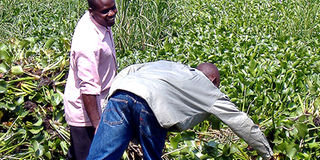New plan to save lake under weed

Men try to pull out the hyacinth weed that has covered part of Lake Vitoria in Kisumu's at Kichinjio beach. A section of residents whose livelihoods depend on the lake have began manually uprooting the weed and seeks support from the government to undertake the ant hill task. PHOTO/ JACOB OWITI
What you need to know:
- Lake Victoria supports 30 million people but is today teetering on brink of calamity
Solid waste on Lake Victoria, coupled with the overgrown hippo grass and the obnoxious water hyacinth have been causing environmentalists working in the region sleepless nights.
The lake, which supports an estimated population of 30 million people across East Africa, is becoming increasingly threatened by pollution.
Car washers are common in the towns around the lake, emptying their oily stuff into the otherwise fresh water.
The lake, the second largest fresh water mass in the world after Lake Superior in North America, is used as a source of the most delicious and nutritious fish varieties among them the Nile Perch, tilapia and fingerlings commonly known as Omena.
The lake is at the same time the source of water for both domestic and industrial use in the region.
It remains filthy despite spirited campaigns by environmentalists and non-governmental organisations (NGOs) to end pollution.
According to environmentalist Peter Mireri of the Friends of Lake Victoria lobby the lake is excessively polluted.
“The lake has a lot of silt due to poor land use among the communities that live close to the shoreline,” he said.
Mr Mireri adds: “The shorelines have been used as sinks or cesspools where urban and rural wastes are deposited.”
Glorious past
However, the anticipated launch of the second phase of Lake Victoria Environmental Management Programme (LVEMP-2) project is once again raising hopes that the lake could well be on the way back to its glorious past.
Says Lake Victoria Basin Commission Deputy executive secretary Mr Meraji Msuya, “The preparation for this project that started in 2004 under the coordination of EAC secretariat has been completed and the project was appraised by the World Bank lead financing partner between October 1 and 16, 2008.”
Mr Msuya disclosed that the project is set to take off before July after the WB board meeting next month in Washington DC that is expected to approve the funding.
WB regulations demand that projects take off within 60-days of approval.
The plan will last for eight years, and will be split into three adaptable programme loan (World bank lending instruments) phases with a budget of $114.8 million (Sh9.2 billion).
Funds will come from the Global Environmental Facility, (GEF), Sweden and the three governments of Kenya, Uganda and Tanzania..
According to Mr Msuya, phase one of the project will take four years to implement.
“This phase will involve Kenya, Tanzania and Uganda because these countries already have experience in the cooperative management of earlier phases,” said Mr Msuya.
Burundi and Rwanda will be incorporated in the second phase on the basis of meeting eligibility criteria, satisfying policy and project triggers, and demonstrating the project implementation eagerness, a brief on the project prepared by LVBC which is co-ordinating the programme on behalf of EAC stated.
Phase 3 will further scale up interventions that Kenya, Tanzania and Uganda would implement under phase one.
While the first phase concentrated on research, Mr Msuya said that a substantial part of the funds will be spent on socio-economic development of the close to 30 million people who derive their livelihoods from Lake Victoria basin in EAC member states.
Said Mr Msuya, “Unless we incorporate the people into this project there is no way we shall deal with the real issues. We are looking on how to incorporate them so that they can also participate in the conservation of the lake environment.”
With the anticipated launch, the three senior EAC partner states have already began the process of recruiting staff as preparations for the multi-million dollar project enters the final phase.
Mr Msuya said that Kenya was the last to kick off the recruitment process with the recent notice by the Ministry of Environment and Mineral Resources calling on interested candidates to apply for jobs.
The project aims to reduce the flow of pollutants into the lake, reversing some of the adverse environmental developments of the past.
Urbanisation
It stated in its proposal, “The Lake Victoria Basin is a vast reservoir of biodiversity, facing a myriad of environmental challenges from the fishing industry, urbanisation, pollution and land-use changes in the catchment area.”
Thus, much effort was spent on research on deterioration of water quality, land degradation, deforestation, destruction of wetlands, inadequate collection and treatment of industrial and municipal wastes.
It also addressed the menace of the water hyacinth, destructive fishing and fish processing methods and inadequate human and institutional capacities for research and management functions.



